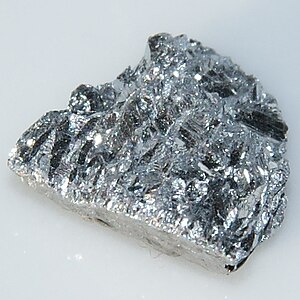What does antimony mean?
Definitions for antimony
ˈæn təˌmoʊ nian·ti·mo·ny
This dictionary definitions page includes all the possible meanings, example usage and translations of the word antimony.
Princeton's WordNet
antimony, Sb, atomic number 51noun
a metallic element having four allotropic forms; used in a wide variety of alloys; found in stibnite
Wiktionary
antimonynoun
A chemical element (symbol Sb) with an atomic number of 51. The symbol is derived from Latin stibium.
antimonynoun
The alloy stibnite
Etymology: From antimonium attested in the eleventh century; see also here.
Samuel Johnson's Dictionary
ANTIMONYnoun
Antimony is a mineral substance, of a metalline nature, having all the seeming characters of a real metal, except malleability; and may be called a semimetal, being a fossile glebe of some undetermined metal, combined with a sulphurous and stony substance. Mines of all metals afford it; but chiefly those of silver and lead; that in gold mines is reckoned best. It has also its own mines in Hungary, Germany, and France. It is found in clods or stones of several sizes, bearing a near resemblance to black lead, only being lighter and harder. Its texture is full of little shining veins or threads, like needles; brittle as glass. Sometimes veins of a red or golden colour are intermixed, which is called male antimony; that without them being denominated female antimony. It fuses in the fire, though with some difficulty; and dissolves more easily in water. When dug out of the earth, it is put into large crucibles, fused by a violent fire, and then poured into cones, which make the crude antimony of the shops. Of these cones the top is the purest part, and the base the foulest. It destroys and dissipates all metals fused with it, except gold; and is therefore useful in refining. It is a common ingredient in speculums, or burning concaves; serving to give them a finer polish. It makes a part in bell metal; and renders the sound more clear. It is mingled with tin, to make it more hard, white, and sound; and with lead, in the casting of printers letters, to render them more smooth and firm. It is a general help in the melting of metals, and especially in casting of cannon balls. In pharmacy it is used under various forms, and with various intentions, chiefly as an emetick. It had no place in medicine before the fourteenth century; and was generally neglected, till Paracelsus brought it into esteem, in the beginning of the sixteenth century; but much mischief was done by it, till the proper methods of preparing it were, after a long course of experiments, discovered. Ephraim Chambers
Etymology: The stibium of the ancients, by the Greeks called στίμμι. The reason of its modern denomination is referred to Basil Valentine, a German monk; who, as the tradition relates, having thrown some of it to the hogs, observed, that, after it had purged them heartily, they immediately fattened; and therefore, he imagined, his fellow monks would be the better for a like dose. The experiment, however, succeeded so ill, that they all died of it; and the medicine was thenceforward called antimoine; antimonk.
Wikipedia
Antimony
Antimony is a chemical element with the symbol Sb (from Latin: stibium) and atomic number 51. A lustrous gray metalloid, it is found in nature mainly as the sulfide mineral stibnite (Sb2S3). Antimony compounds have been known since ancient times and were powdered for use as medicine and cosmetics, often known by the Arabic name kohl. The earliest known description of the metal in the West was written in 1540 by Vannoccio Biringuccio. China is the largest producer of antimony and its compounds, with most production coming from the Xikuangshan Mine in Hunan. The industrial methods for refining antimony from stibnite are roasting followed by reduction with carbon, or direct reduction of stibnite with iron. The largest applications for metallic antimony are in alloys with lead and tin, which have improved properties for solders, bullets, and plain bearings. It improves the rigidity of lead-alloy plates in lead–acid batteries. Antimony trioxide is a prominent additive for halogen-containing flame retardants. Antimony is used as a dopant in semiconductor devices.
Webster Dictionary
Antimonynoun
an elementary substance, resembling a metal in its appearance and physical properties, but in its chemical relations belonging to the class of nonmetallic substances. Atomic weight, 120. Symbol, Sb
Etymology: [LL. antimonium, of unknown origin.]
Wikidata
Antimony
Antimony is a chemical element with symbol Sb and atomic number 51. A lustrous gray metalloid, it is found in nature mainly as the sulfide mineral stibnite. Antimony compounds have been known since ancient times and were used for cosmetics; metallic antimony was also known, but it was erroneously identified as lead. It was established to be an element around the 17th century. For some time, China has been the largest producer of antimony and its compounds, with most production coming from the Xikuangshan Mine in Hunan. The industrial methods to produce antimony are roasting and subsequent carbothermal reduction or direct reduction of stibnite with iron. The largest applications for metallic antimony are as alloying material for lead and tin and for lead antimony plates in lead-acid batteries. Alloying lead and tin with antimony improves the properties of the alloys which are used in solders, bullets and plain bearings. Antimony compounds are prominent additives for chlorine- and bromine-containing fire retardants found in many commercial and domestic products. An emerging application is the use of antimony in microelectronics.
Chambers 20th Century Dictionary
Antimony
an′ti-mun-i, n. a brittle, bluish-white metal of flaky, crystalline texture, much used in the arts and in medicine.—adjs. Antimōn′ial, Antimon′ic. [Through Fr. from Low L. antimonium, of unknown origin, prob. a corr. of some Arabic word.]
The Nuttall Encyclopedia
Antimony
a brittle white metal, of value both in the arts and medicine.
U.S. National Library of Medicine
Antimony
A metallic element that has the atomic symbol Sb, atomic number 51, and atomic weight 121.75. It is used as a metal alloy and as medicinal and poisonous salts. It is toxic and an irritant to the skin and the mucous membranes.
The Foolish Dictionary, by Gideon Wurdz
ANTIMONY
A metallic substance discovered by Valentine in 1450, and now extensively used in the arts--particularly poker.
Suggested Resources
antimony
The antimony symbol -- In this Symbols.com article you will learn about the meaning of the antimony symbol and its characteristic.
Anagrams for antimony »
antinomy
Numerology
Chaldean Numerology
The numerical value of antimony in Chaldean Numerology is: 1
Pythagorean Numerology
The numerical value of antimony in Pythagorean Numerology is: 3
Popularity rank by frequency of use
References
Translations for antimony
From our Multilingual Translation Dictionary
- antimoonAfrikaans
- أنتيمونArabic
- сурмаBelarusian
- антимонBulgarian
- antimoniCatalan, Valencian
- antimonCzech
- antimoniWelsh
- antimonDanish
- AntimonGerman
- αντιμόνιοGreek
- antimonoEsperanto
- antimonioSpanish
- antimonEstonian
- antimonioaBasque
- سرمه, روی سخته, انتیموانPersian
- antimoniFinnish
- antimonFaroese
- antimoineFrench
- antimoonWestern Frisian
- antamónIrish
- antamònScottish Gaelic
- antimonioGalician
- antimoanManx
- אנטימוןHebrew
- अंजनHindi
- antimonHungarian
- ծարիրArmenian
- antimonioInterlingua
- antímonIcelandic
- antimonioItalian
- אַנטִימוֹןHebrew
- アンチモニー, アンチモンJapanese
- სტიბიუმიGeorgian
- сурьмаKazakh
- អង់ទីម៉ាន់Khmer
- ಆಂಟಿಮನಿKannada
- 안티몬, 안티모니Korean
- antymonyCornish
- stibiumLatin
- AntimonLuxembourgish, Letzeburgesch
- stibisLithuanian
- antimonsLatvian
- антимонMacedonian
- будагMongolian
- antimoniMalay
- antimonjuMaltese
- antimonium, antimoon, stibiumDutch
- antimonNorwegian
- antymonPolish
- antimoniu, stibiuRomanian
- стибиум, сурьмаRussian
- antimon, антимонSerbo-Croatian
- antimónSlovak
- antimonSlovene
- antimonAlbanian
- antimonSwedish
- அந்திமன்Tamil
- сурьмаTajik
- พลวงThai
- antimonTurkish
- сурмаUkrainian
- انتشارUrdu
- сурьма, sur’maUzbek
- antimonVietnamese
- 锑Chinese
Get even more translations for antimony »
Translation
Find a translation for the antimony definition in other languages:
Select another language:
- - Select -
- 简体中文 (Chinese - Simplified)
- 繁體中文 (Chinese - Traditional)
- Español (Spanish)
- Esperanto (Esperanto)
- 日本語 (Japanese)
- Português (Portuguese)
- Deutsch (German)
- العربية (Arabic)
- Français (French)
- Русский (Russian)
- ಕನ್ನಡ (Kannada)
- 한국어 (Korean)
- עברית (Hebrew)
- Gaeilge (Irish)
- Українська (Ukrainian)
- اردو (Urdu)
- Magyar (Hungarian)
- मानक हिन्दी (Hindi)
- Indonesia (Indonesian)
- Italiano (Italian)
- தமிழ் (Tamil)
- Türkçe (Turkish)
- తెలుగు (Telugu)
- ภาษาไทย (Thai)
- Tiếng Việt (Vietnamese)
- Čeština (Czech)
- Polski (Polish)
- Bahasa Indonesia (Indonesian)
- Românește (Romanian)
- Nederlands (Dutch)
- Ελληνικά (Greek)
- Latinum (Latin)
- Svenska (Swedish)
- Dansk (Danish)
- Suomi (Finnish)
- فارسی (Persian)
- ייִדיש (Yiddish)
- հայերեն (Armenian)
- Norsk (Norwegian)
- English (English)
Word of the Day
Would you like us to send you a FREE new word definition delivered to your inbox daily?
Citation
Use the citation below to add this definition to your bibliography:
Style:MLAChicagoAPA
"antimony." Definitions.net. STANDS4 LLC, 2024. Web. 5 May 2024. <https://www.definitions.net/definition/antimony>.



Discuss these antimony definitions with the community:
Report Comment
We're doing our best to make sure our content is useful, accurate and safe.
If by any chance you spot an inappropriate comment while navigating through our website please use this form to let us know, and we'll take care of it shortly.
Attachment
You need to be logged in to favorite.
Log In